- Overview
- Challenges and Opportunities
- Savannah Trial Garden
- Griffin Trial Garden
- Tropical Plants in Annual Beds
- Landscape Considerations for Tropical Plants
- Production Consideration
- Selling Foliage for Landscape
- Marketing Strategies
- Summary
- Tables
Overview
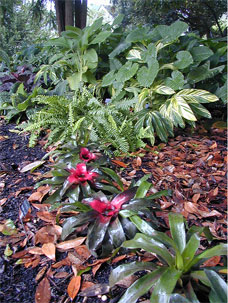 Figure 1. Tropical plants in the landscape can create an exotic garden, an impression of an island paradise. or a tamed jungle with all of its magic and mystery.
Figure 1. Tropical plants in the landscape can create an exotic garden, an impression of an island paradise. or a tamed jungle with all of its magic and mystery.Consumers and avid home gardeners have become more adventurous with their plant choices, and are prompting other growers and landscapers to become more savvy in catering to this spirit of landscape adventure. Anything that adds interest to the landscape design and makes it unique can evolve into a trend - incorporating more non-traditional plants, for example, such as exotic and tropical annuals and perennials. But Flowers are taking a step back, leaving the landscapers to focus on the foliage instead, and to explore variations in texture and color.
Challenges and Opportunities for the Ornamental Industry in Georgia
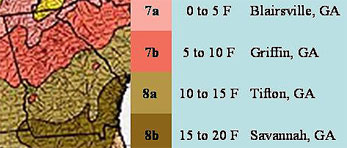 Figure 2. Georgia climate zones with average minimum temperature ranges and examples of cities in those areas, adapted from USDA hardiness map (www.usda.gov).
Figure 2. Georgia climate zones with average minimum temperature ranges and examples of cities in those areas, adapted from USDA hardiness map (www.usda.gov).The seemingly insatiable consumer demand for new plants presents a challenge and an opportunity for the Georgia ornamental industry. Georgia has a diverse climate (Fig. 2), from zone 8b in the South and coastal areas, where minimum average temperatures range from 15-20 degrees Fahrenheit, to zone 7a in the northern mountain region, where minimum average temperatures range from 0-5 degrees Fahrenheit. A small part of North Georgia is in Zone 6b where minimum average temperatures range from -5 to 0 degrees Fahrenheit. The largest area in the state is divided almost equally between zones 8a (minimum average temperatures range from 10-15 degrees F) and 7b (minimum average temperatures range from 5-10 degrees F).
Each of these areas is characterized by unique climate, which presents both a challenge and an opportunity for industry and consumers. On one hand, recommending plants that would do well in all areas is difficult; on another, plants that grow well in one area but not in another provide an excellent opportunity for local use. This is especially true for tender plants that may thrive in the warm weather and may even come back the next season in one area, but not in other areas. Such plants may receive enormous recognition seven to eight months of the year, but because they are not truly perennial (able to survive the cold weather and grow back the next season), they may not get recommended and/or marketed by the industry. Some of these plants, termed tender perennials, tropicals, etc. , may receive much attention in northern areas in Florida, for example, while few growers and garden centers in South Georgia market them - although both are in the same climate zone. Thus the consumer in Georgia may be largely unaware of the benefits of these tender perennials.
In addition, many plants from the tropics hold up very well in Georgia's challenging spring and summer months, and can tolerate extremes of heat, humidity, and moisture. Some are so uniquely adapted to low-light environments that they can be used in deep-shade areas in a garden. Shade gardening, however, has challenged landscapers because of a limited selection of species, which do well in low light environments. Few flowering plants perform well in such areas, especially where light levels dip below 1000 ft-c; for example, under oak shade, light levels frequently average around 500 ft-c. Tropical plants adapted to deep shade are uniquely suited to thrive in low-light habitats with high humidity. Many of them, because of their epiphytic origins, are capable of using small amounts of dew moisture, which accumulates in the early morning hours during summer, either by direct absorption through the foliage or by channeling moisture into their leaf whorl.
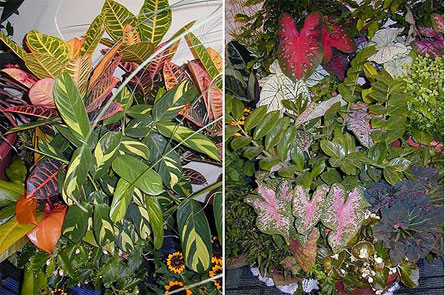 Figure 3. Colorful combination gardens created exclusively with tropical foliage plants. The combination container on the left features high-light adapted plants and can be used on patios, sun decks, around pools, etc. The container on the right uses plants best adapted for low-light environments. During the cold months, a combination garden can be brought inside the house and treated as an indoor planting. This further illustrates the versatility of tropical plants.
Figure 3. Colorful combination gardens created exclusively with tropical foliage plants. The combination container on the left features high-light adapted plants and can be used on patios, sun decks, around pools, etc. The container on the right uses plants best adapted for low-light environments. During the cold months, a combination garden can be brought inside the house and treated as an indoor planting. This further illustrates the versatility of tropical plants.Tropical plants may also be used in annual beds in combination with traditional flowering plants. The bold vegetative look of foliage plants can add height and texture, while achieving a tropical look that is attractive and highly sought after. Yet the use of tropical plants may not be limited to landscape. Combination gardens in various-sized containers have become very popular with consumers. Visually appealing and colorful combinations using tropical plants alone or in combination with other flowering plants can be created (Fig. 3). Such gardens hold high appeal for gardeners in urban areas because of the limited garden space.
Finally, numerous new tropical species and cultivars - many with bold, multicolored foliage, and quite a few flowering varieties - have come to market in recent years. Some new introductions show improved cold tolerance and have been used successfully in landscapes throughout southern states, especially in Florida.
Further exploration of the landscape potential of new ornamental species and cultivars is needed and could provide recommendations and guidelines to the industry and consumers. The goals of these investigations were to achieve an aesthetically pleasing landscape while experimenting with mixing various plant habits, leaf textures and colors, and even flowers, and to raise consumer awareness, both at industry and public levels, of the alternative uses of tropical plants in the landscape.
This publication presents plant performance data collected over a three-year period in trials from two different Georgia environments, a coastal area and a mid-state area.
Trial Gardens Locations, Conditions, and Plant Performance
Tropical Plant Trial Garden at the Bamboo Farm and Coastal Gardens in Savannah, Georgia (evaluation period April 2002 - October 2004)
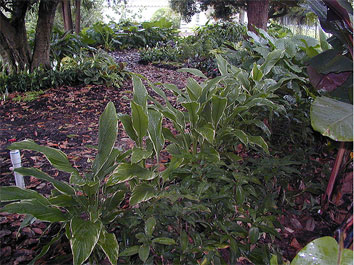 Figure 4. Full shade bed at the Bamboo Farm and Coastal Gardens in Savannah, GA.
Figure 4. Full shade bed at the Bamboo Farm and Coastal Gardens in Savannah, GA.- Climate conditions: USDA Hardiness Zone 8b, Minimum Temperature Average Range 15 to 20 F.
- Species planted: bromeliads, ficus, philodendron, schefflera, spathiphyllum, ferns, alocasia, colocasia, ornamental banana, gingers (alpinia, calathea, kaempferia, cornukaempferia, curcuma, globba, siphonochilus, costus).
- Light conditions: full shade (light levels 500 to 1100 ft-c) (Fig. 4).
- Raised beds (soil depth of 8-10 inches) amended with 0.1 pounds of nitrogen per 100 sq.ft. at planting and once in mid summer.
- Plant size at planting: 6" containers, colocasia, 3-gal containers.
- Plant spacing: 12" x 12" for the 6" container size, 24" x 24" for 3-gal containers.
- Irrigation: for the first 4 weeks after planting, plants were watered twice per week and for the remainder of the season received 38 inches of natural irrigation (from April to December, 2002).
Plant Performance and Hardiness
Throughout the growing period April - December 2002, all species planted in the garden did very well with some species growing as much as one and a half times in size, creating a beautiful shade landscape.
Although most alocasias and colocasias grow best in high light, they grew well in the shade garden, while retaining a more compact growth (Table 2). This may be a desirable trait for small-sized gardens. We noted that the strong-colored colocasia foliage lost the intensity of its deep purple coloration.
Gingers (Peacock and Hidden Gingers) showed excellent performance and strong landscape impact (Table 2). Some of the best performers were Cornukaempferia 'Jungle Gold', Kaempferia 'Grande', Curcuma 'Emperor', Globba 'White Dragon', and Calathea tigrinum. With the exception of C. tigrinum and Siphocilius decora , all other gingers produced flowers throughout the season (Fig. 8).
Ficus, philodendron, schefflera, bromeliads and spathiphyllum showed excellent performance and strong landscape impact (Table 2).
No major pest or disease problems were encountered during the season of active growth and no pesticides were applied. No herbivory by deer was noted.
Planting Recommendations
High visual impact combinations were achieved by using:
- Low to medium plants: philodendrons ('Black Cardinal', 'Prince of Orange'), bromeliads (Guzmania minor magnifica , Neoregelia 'Grace', and Aechmea fasciata 'Morgana'), Spathiphyllum 'Petite', Homalomena 'Purple Sword', Kaempferia 'Alva', Kaempferia 'Grande', Schefflera arboricola 'Luseanne', Cornukaempferia 'Jungle Gold', and ferns (Selaginella involvens 'Aurea', Arachniodes simplicior, Onoclea sensibilis);
- Medium to tall plants: Ficus benjamina 'Midnight', Schefflera 'Nova', Calathea tigrinum, Calathea 'Ice Blue', Calathea 'Silver Plate', Carludovica 'Jungle Drums', Alocasia odora, Alocasia wentii, Alocasia gagaena, Globba 'White Dragon', Curcuma 'Emperor', Siphonochilus decora, Costus amazonicus, Alpinia zerumbet variegata, Philodendron pinnatifudim;
- Tallest plants: Alocasia macrorrhiza, Colocasia esculenta nancyana, Colocasia illustris, Colocasia esculenta 'Black Magic' and Musa zebrina; should be planted toward the back of the border or in a center of an isle bed.
Plant Hardiness
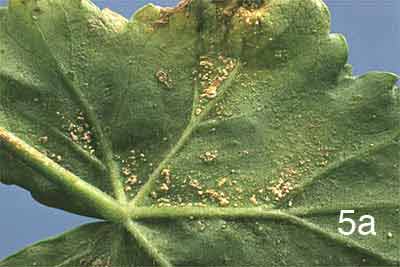
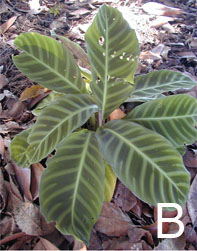
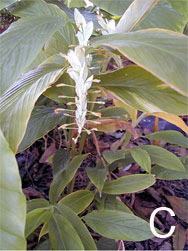
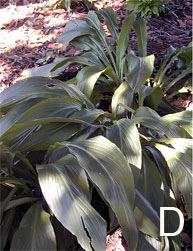
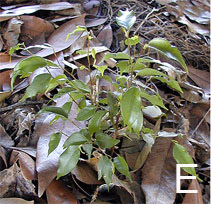
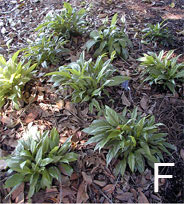
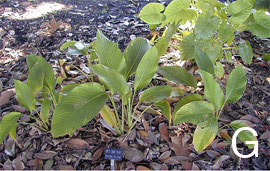
Figure 5. Regeneration and growth of plants in the Savannah Trial garden. A) Alocasias and Colocasias; B) Calathea tigrinum; C) Globba 'White Dragon'; D) Siphonocilius decora; E) Ficus benjamina 'Midnight'; F) Spathiphyllum 'Petite'; and G) Calathea 'Ice Blue'.
The two winter periods of 2002-2004 provided opportunities to test plant hardiness. We had numerous occurrences when night temperatures were between 19 to 25 degrees F.
Percent survival and growth in the second and third year for species and cultivars that survived the winters are listed in Table 1 and illustrated in Figure 5. Remaining species not listed in the table were not root-hardy and did not survive the first winter.
Tropical Plant Trial Garden at the Research and Education Gardens, Griffin, Georgia (evaluation period May-December 2004)
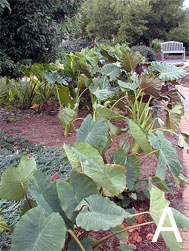
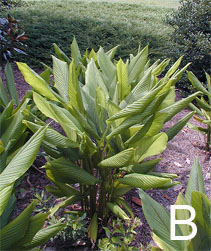
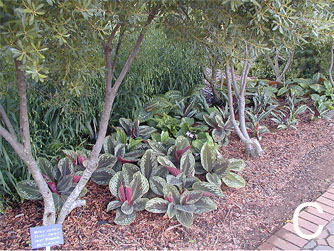
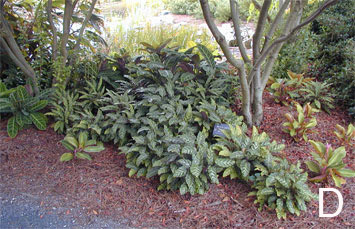
- Climate conditions: USDA Hardiness Zone 7b Minimum Temperature Average Range 5 to 10 - F.
- Species planted: alocasia, colocasia, gingers (calathea, kaempferia, cornukaempferia, curcuma, begonia). For a complete list of species and cultivars refer to Table 2 and Table 3.
- Light conditions:
- full sun (Fig. 6A)
- part sun (morning shade, midday sun, afternoon shade) (Fig. 6B)
- part shade (no direct sun) (Fig. 6C)
- full shade (light levels 800 to 1100 ft-c) (Fig. 6D)
- Raised beds (soil depth of 8-10 inches) amended with 0.1 pounds of nitrogen per 100 sq.ft. at planting and once in mid-summer.
- Plant Size at planting: 6" containers, alocasia and colocasia, 1-gal containers.
- Plant spacing: 12" x 12" for the 6" container size; 18" x 18" for 1-gal containers.
- Irrigation: for the first 4 weeks after planting plants were watered twice per week and for the reminder of the season (May to November) received 35 inches of natural irrigation.
Plant Performance and Hardiness
Throughout the growing period May - November 2004, most species planted in the garden did very well, with some growing as much as one and a half times in size, creating attractive landscape beds.
We planted alocasias and colocasias in a variety of areas, from full sun exposed sites to dappled shade. The best performers were the Alocasia cultivars 'Hilo Beauty', 'Williams Hybrid', and 'New Guinea Gold' and Colocasia 'Red Stem', C. nancyana (Table 2 and Table 3). We noted that the purple-colored underside of Alocasia 'Williams Hybrid' foliage lost some intensity in the full sun site. Also, the stem thickness and offshoot formation in Alocasia 'Williams Hybrid', Colocasia 'Red Stem', and C. nancyana was increased when grown in full sun.
Gingers (Peacock and Hidden Gingers) showed excellent performance and strong landscape impact (Table 2 and Table 3). Some of the best performers were Cornukaempferia and Kaempferia , Curcuma , and Calathea .
Curcuma species were planted in part sun/shade locations where they showed consistent strong growth and flowering. Curcuma 'Aussie Plume' and 'Giant Plume' produced abundant flowers throughout the growing period with an average of 3 blooms per plant at any given time.
Kaempferia species were planted in full shade where they showed consistent strong growth and some flowering ( Kaempferia 'Silver Spot'). The two new to the trade Kaempferias, 'Raven' and 'Silver Diamonds', with their upright habit and patterned foliage were especially successful in attracting the notice of visitors to the garden.
Calathea species were planted in full shade where they showed consistent strong growth and even some flowering. Best performers were C. tigrinum , the tallest species, C. rubifarba , medium height, and C. albertii , low height. C. 'Zebrina', a sport of C. tigrinum , has beautiful lime-green and brown patterned foliage, which stands out well in dark, shady locations. Calathea loesnerii 'Kopper Krome' developed 1-2 pink-colored flowers in late summer. The individual flowers lasted 4-5 weeks.
Begonia carolinifolia and B. poponeii showed consistent strong growth. The Giant Hardy Begonia ( B. poponeii ) was planted in full shade and in partial sun. The large light-green foliage of B. poponeii and the palmate burgundy leaves of B. carolinifolia lent markedly tropical effect.
No major pest or disease problems were encountered during the season of active growth and no pesticides were applied.
No herbivory by deer was noted.
Planting Recommendations
Due to limited number of species in the trial garden, landscape beds were planted according to the light preferences of the plants. Nevertheless, the following plantings achieved high visual impact.
- Full shade to part shade (no direct sun) areas: Calathea tigrinum, C. zebrina , Begonia poponeii; B. carolonifolia , Kaempferia 'Silver Diamonds', Kaempferia 'Grande', Kaempferia 'Raven' as tall to medium height plants; Calathea albertii , C. rubifarba , C. 'Kopper Krome', Kaempferia 'Silver Spot', and Cornukaempferia 'Jungle Gold' as low height plants;
- Part sun: Alocasia 'New Guinea Gold'; Curcuma 'Emperor', Curcuma 'Aussie Plume' and Curcuma 'Giant Plume'
- Full sun: Alocasia 'Hilo Beauty', A. 'Williams Hybrid', Colocasia 'Red Stem', and C. nancyana.
Plant Hardiness
Evaluation is on-going.
Tropical Plants in Annual Beds
Tropical foliage plants may be used in annual beds in combination with traditional flowering plants. The bold vegetative look of foliage plants can add height and texture, while achieving a tropical look that is attractive and highly sought. Many of these plants tolerate high light conditions and are therefore suitable for use in combination with traditional summer bedding plants such as salvia, marigold, begonia, zinnia, etc. For light requirements of individual species, refer to Table 4. Foliage texture varies from fine (asparagus and Boston ferns) to coarse (crotons) (Table 4). A wide variety of foliage colors, including bright yellow, orange and red, are typical of older croton varieties. The newer crotons offer a variety of leaf shapes as well.
Landscape Considerations for Tropical Plants
If you are considering using foliage plants, you should trial them outdoors, on a limited basis under the specific conditions (temperature, light intensity, humidity, air movement, soil type and topography) they will encounter in your particular landscape setting. For best results, the soil should be well-drained, rich in organic matter, with a pH range of 5 to 6.5. The soil should not be allowed to become exceedingly dry.
High visual impact combinations using plants evaluated in our trials are illustrated in Figure10.
Production Considerations
Growers in Georgia have several options for obtaining starter material, including rooted liners in cell packs and small pots, rooted air layers and rooted cuttings. Plants can also be purchased as finished products (cell packs to small size pots) and resold without spending any production time in the greenhouse. A few of the taller species can be grown or purchased in larger containers (6-inch and larger). Production times vary depending on species, container size, growing season and geographic location.
Root-zone heating (70 degrees F) can be used to speed up production. Most of the plants listed in Table 2 and Table 3 can be produced under light levels of 5,000 to 7,000 footcandles. These growing conditions would produce vigorous, compact liners or potted plants well adapted to northern summer conditions, ranging from 75 percent shade to full sun. If plants are started in northern greenhouses, they may require an acclimatization period under a partially shaded area outside with higher light levels before exposing them to full sun landscapes.
The plants should be trialed outdoors, on a limited basis under the specific conditions (temperature, light intensity, humidity, air movement, soil type and topography) they will encounter in a landscape setting. For best landscape results with plants listed in Table 2 and Table 3, the soil should be well-drained, rich in organic matter, with a pH range of 5 to 6.5. The soil should not be allowed to become exceedingly dry.
Selling Foliage for Landscapes
Foliage plants offer landscapers new design elements and can help create a niche for growers. Growers should compare production costs versus shipping costs of finished plants. Foliage plants for landscape should be marketed right along with bedding plants. However, the foliage should be priced appropriately because of plants' higher production and/or shipping costs. The foliage could be marketed as specialty annuals.
A number of plants discussed are used in central and southern Florida landscapes and as interiorscape plants in the north. It is very likely that some landscapers and consumers may identify these plants as for "interior use only" and may be reluctant to plant them outdoors.
Here are some points to you can discuss with potential customers who may be reluctant to use foliage plants outdoors.
- Foliage plants placed in outdoor beds should be considered annuals that will not last "forever. " This may be a misconception based on the expectation of interior foliage plants.
- Foliage plants have potential bedding applications with flowering plants offering additional textures, colors and height to landscapes.
- Foliage plants are essentially maintenance free in landscapes having few insect and disease problems and do not require removal of dead flowers.
- Most foliage plants thrive in humid conditions and handle excess moisture well. Most plants in Table 2 and Table 3 tolerate chilling, especially if night temperatures in late summer drop slowly. Several of the plants even withstand freezing temperatures for short periods if humidity is high and the air is still.
- The majority of foliage plants perform very well in low-light environments, where few flowering plants do.
Marketing Strategies
Here are a few marketing tips to help you sell foliage plants as annuals.
- Plant trial and demonstration gardens, both in sun and shade areas, and incorporate foliage plants along with traditional flowering annuals and perennials.
- Volunteer to plant display beds in high traffic areas in local municipalities.
- Sponsor educational seminars for landscapers and gardening clubs and invite expert speakers.
- Sponsor an open house with tours of your greenhouse/garden center and display areas with foliage demonstration plantings.
- Advertise a garden photo contest and submit a story about the winners to local media outlets.
- Write an article on the use of foliage for local and/or regional media newspapers and/or magazines.
- Volunteer to be on a local radio garden program to discuss the use of outdoor foliage.
- Distribute informational packages that discuss appropriate plant combinations, design ideas, planting and care recommendations.
- Invite a garden club or landscape group for lunch and test ideas.
- Search the Internet for ideas and sample marketing tactics.
Summary
A wide variety of new tropical plants are available on the market. Many have shown marked potential for the landscape in Georgia. Depending on the climate zone, some of these species can be treated as perennials, while others are strictly annuals.
Tropical plants can create an aesthetically pleasing landscape with a great variety of plant habits, foliage textures and colors, and even flowers. They can widen the plant palette for landscapers, growers, and consumers in Georgia.
The Foliage Trial Gardens at the University of Georgia were made possible by donations from Fafard, Agri-Starts Inc., Twyford International Inc., and Casa Flora Inc., and with grant support from the National Foliage Foundation.
Tables
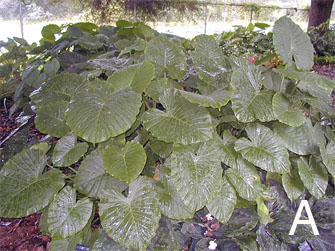
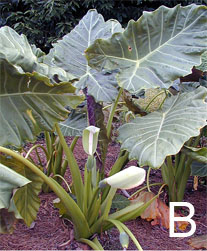
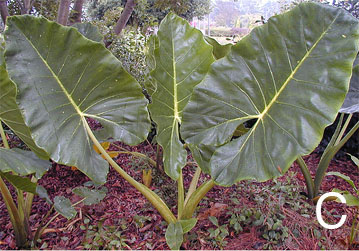
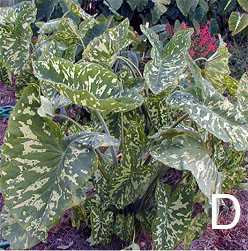
Figure 7. Alocasias. A) Alocasia gagaena; B) Alocasia "Williams Hybrid"; C) Alocasia "New Guinea Gold"; and D) Alocasia "Hilo Beauty".
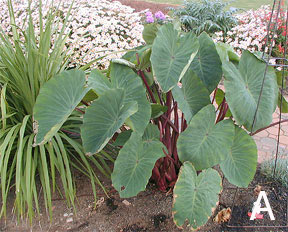
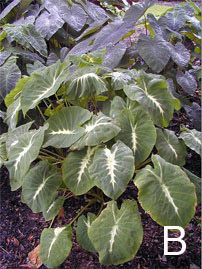
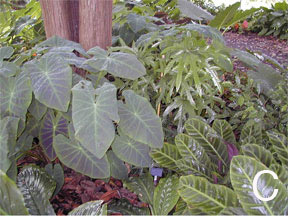
Figure 8. Colocasias. A) Colocasia "Red Stem"; B) Colocasia "Black Magic" (top) and Colocasia nancyana (bottom); and C) Colocasia illustris (left).

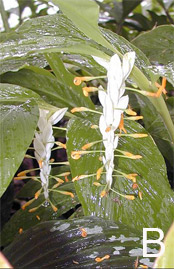
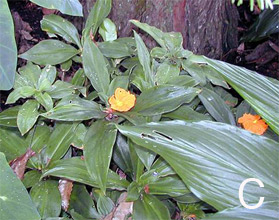
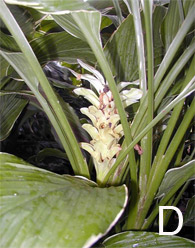
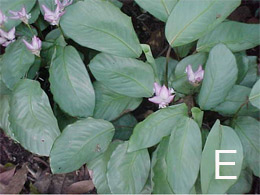
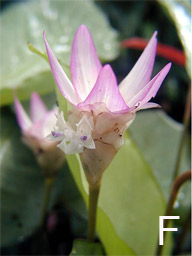
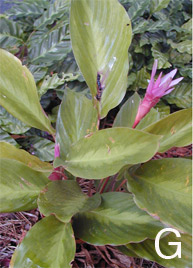
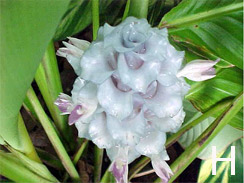
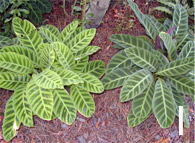
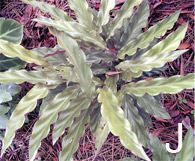

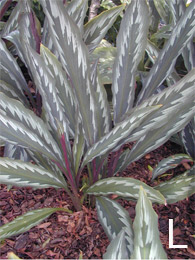
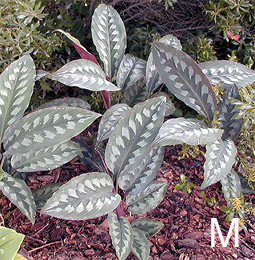
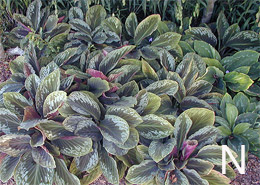
Figure 9. Gingers. A) Circuma "Aussie Plume"; B) Globba "White Dragon"; C) Costus amazonicus; D) Curcuma "Emperor"; E)-F) Calathea "Silver Plate"; G) Calathea "Kopper Krome;" H) Calathea "Ice Blue"; I) Calathea "Zebrina" and C. tigrinum; J) Calathea rubifarba; K) Calathea albertii; L) Kaempferia "Raven"; M) Kaempferia "Silver Diamonds," N) Cornukaempferia "Jungle Gold".
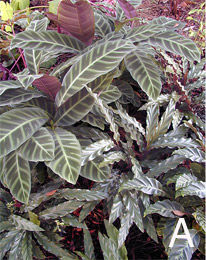
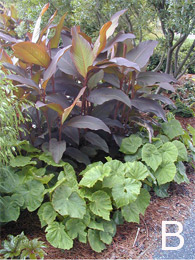

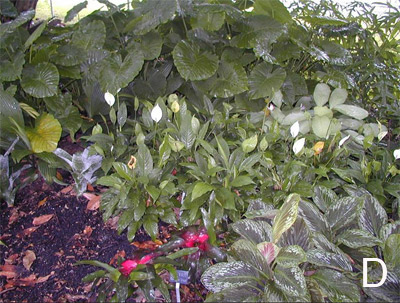
Figure 10. Examples of successful combinations using various foliage textures and colors. A) Planting of Calatheas; B) The foliage of the Giant Hardy Begonia creates nice contrast next to the dark burgundy leaves of Canna; C) Planting of Kaempferias; D) Alocasia gagaena (back), Peace Lily, Calathea,"Silver Plate" and Cornukaempferia "Jungle Gold".
1Extension Horticulture Specialists
2Professor of Horticulture
Status and Revision History
Published on Aug 15, 2005
Published on Feb 27, 2009
Published with Full Review on Feb 13, 2012
Published with Full Review on Feb 17, 2015
Published with Full Review on Oct 21, 2022


























































